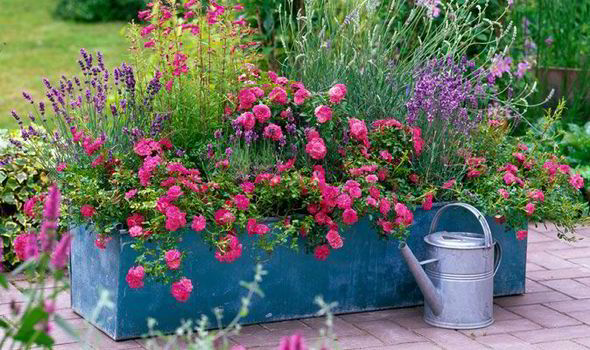PLANTING YOUR POTS AND CONTAINERS

My parents spurred the movement way back in the fifties of combination plantings in decorative pots to place around decks, terraces and front entrance. Back then traditional plantings of geraniums with vinca vines or full containers of one type of plant were what gardeners planted. When my parents visited Germany, their homeland, they were impressed with the European fad of creating beautiful combinations matched in large containers to place around buildings. My mother copied this idea and brought it to Westchester NY. My mother started planting combination pots and placed them out for sale.
They were both beautiful and unusual and attracted a lot of attention. Sprainbrook called them European combinations. Since then a whole industry has been built around producing 4 ½’ pots for planters. Proven Winners came onto the market scene selecting and hybridizing plants for this purpose. Other companies competed and more new varieties where introduced.
Finding superior plants required that these plants be grown vegtetatively to clone their genes. Vegetatively grown plants are more expensive to grow because of the added amount of work it takes to produce them. However they are so far superior in both flower power and hardiness to the common old seed varieties that have been standard for years. It is well worth the extra money. The huge selections we now have get bigger and better each year.
Planting containers is a challenge to your creativity. In the old days it was red geraniums with vinca vines or a window box filled with one color of petunias. The combination process is simple and very rewarding if you follow a few basic rules. With time many home gardeners have become very good at this technique. When you have the opportunity to choose from a large selection of beautiful plants, it is difficult to make a mistake. Below are rules to follow which will reward you with success. .
Follow my simple 6 point program:
1 – Purchase healthy organic plants: Organically grown plants are stronger, healthier, and produce bigger and more prolific flowers.
2 – Soil: The strength of any plant is in its root system and a good root system is depended on the soil. Probably the easiest thing is to buy our soil it has everything mixed in it. My father spent a great deal of time in producing the best soil available to grow his plants in. Customers demanded that we sell it to them. For those who do not have access to our soil refer to the article I wrote on soils posted on the Naturalgardennews.com web site.
3 – Selection of plants: Selecting the right plant for the right location. Shade plants for a shady location, sun plants for a sunny location. Plants for windy spots etc. A great deal of research can be done on this subject. Your best bet is to grab a salesperson to give you some suggestions. You usually use trailers for the edge and uprights for the center. Size and height usually depend on the size of your container. It is important to know what you want the plants to do for you. But some experimentation over the years may also be needed as well as visual focus on other plantings in your area. Putting color combinations together is usually an easier challenge and fun for most. This is an exciting time of the year where your own creation can be unique to you.
4 – Watering: Watering is probably the most important maintenance problem you face. Too much or too little water can cause death to your plants. The tendency is on outdoor containers to not apply enough water. In pots that dry out quickly double or triple watering is often required. The smaller the container the more frequently it will need to be watered. Remember from my soil article soil should be 25 % water and 25 % air.
5 – Feeding: I follow a weekly feeding program using an organic fertilizer. My favorite fertilizer is “Nature’s Source’ which is a seed based fertilizer. All the nutrients from a plant go back into the seed and Nature’s Source has squeezed all the nutrients out. I have found it to be a fantastic fertilizer creating larger blooms, more prolific blooming and stronger healthier more resistant plants. I like to alternate this fertilizer with the Neptune Harvest line of organic fertilizers. The greater the mix the greater the amazing results.
6 – Grooming and observing: Read these 2 chapters in my book ’12 Steps To Natural Gardening’ on pages 99 and 105. Keep up with weeding, dead heading, trimming, pinching and removal of dead tissue. Like you need to take care of your own grooming so do you need to take care of your plants.
Containers will reward you all summer long. They make your place cheerful, happy and beautiful.



